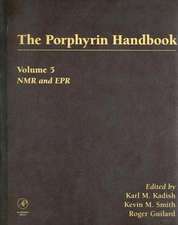Practical Capillary Electrophoresis
Autor Robert Weinbergeren Limba Engleză Hardback – 18 apr 2000
- Illustrated with detailed diagrams of electrophoretic phenomena
- Offers step-by-step methods development schemes
- Presents techniques for developing quantitative, robust, and precise methods
- Includes an extensive troubleshooting guide
- Updates and greatly expands on the first edition-more than 50% of the text is new
- Written by an internationally recognized scientist who is an instructor for American Chemical Society short courses on HPCE
Preț: 1212.04 lei
Preț vechi: 1660.32 lei
-27% Nou
Puncte Express: 1818
Preț estimativ în valută:
231.96€ • 241.53$ • 196.03£
231.96€ • 241.53$ • 196.03£
Carte tipărită la comandă
Livrare economică 10-24 martie
Preluare comenzi: 021 569.72.76
Specificații
ISBN-13: 9780127423562
ISBN-10: 0127423567
Pagini: 462
Dimensiuni: 152 x 229 x 24 mm
Greutate: 0.75 kg
Ediția:Revised.
Editura: ELSEVIER SCIENCE
ISBN-10: 0127423567
Pagini: 462
Dimensiuni: 152 x 229 x 24 mm
Greutate: 0.75 kg
Ediția:Revised.
Editura: ELSEVIER SCIENCE
Public țintă
Analytical chemists and biochemists, technicians, graduate students, and advanced undergraduates.Cuprins
Introduction. Electrophoresis. Micro-Chromatographic Separation Methods. Capillary Electrophoresis. Capillary Electrochromatography. Micromachined Electrophoretic Devices. Historical Perspective. Generic HPCE Systems. Instrumentation. Sources of information on HPCE. Capillary Electrophoresis-A Family of Techniques. Capillary Zone Electrophoresis-Basic Concepts. Electrical Conduction in Fluid Solution. The Language of Electrophoresis. Electroendoosmosis. Efficiency. Resolution. Joule Heating. Optimizing the Voltage and Temperature. Capillary Diameter and Buffer Ionic Strength. Optimizing the Capillary Length. Buffers. Temperature Effects. Buffer Additives. Capillaries. Sources of Bandbroadening. Capillary Zone Electrophoresis-Methods Development. Introduction. Mobility. Solute-Wall Interactions. Separation Strategies. Secondary Equilibrium. Applications and Techniques. Capillary Zone Electrophoresis-Secondary Equilibrium-Micelles, Cyclodextrins, and Related Reagents. Introduction. Micelles. Separation Mechanism. Selecting the Electrolyte System. Elution Range of MECC. Alternative Surfactant Systems. Cyclodextrins. Applications and Methods Development. Chiral Recognition. Capillary Isoelectric Focusing Basic Concepts. Separation Mechanism. pH Gradient Formation. Electrode Buffer Solutions. Resolving Power. Capillaries and Reagents. Performing a Run. Injection. Focusing. Mobilization. Salt Effects. Detection. Applicants. Size Separations in Capillary Gels and Polymer Networks. Introduction. Separation Mechanism. Materials for Size Separations. Size Separations with Non-Replaceable Polyacrylamide. Size Separations with Replaceable Agarose. Introduction to Polymer Networks. Operating Characteristics of Polymer Networks. Additional Materials for Polymer Networks. Applications and Methods Development. Reducing the Problem of Biased-Reptation. Capillary Electrochromatography. Introduction. Modes of CEC. Electroosmotic Flow in CEC. Efficiency of CEC. Operating Characteristics of Packed CEC. Applications. CEC Microfluidic Devices. Injection. Volumetric Constraints on Injection Size. Performing an Injection and Run. Injection Techniques. "Short-End" Injection. Injection Artifacts, Problems and Solutions. Stacking and Trace Enrichment. Detection. On-Capillary Detection. The Detection Problem. Limits of Detection. Detection Techniques. Bandbroadening. Absorption Detection. Fluorescence Detection. Derivatization. Mass Spectrometry. Micropreparative Fraction Collection. Putting it All Together. Selecting the Mode of HPCE. Requirements for Robust Separations. Realistic Compromises. Quantitative Analysis. Sample Preparation. Mobility as Qualitative Tool. Validation. Troubleshooting.
Recenzii
"The Breadth and depth of this text are appropriate for the growing use of capillary electrophoresis.The book conveys general and fundamental concepts in a readable manner combined with an awareness of the need to sort out practical concerns for implementing capillary electrophoresis." --Lisa Holland, Kent State University, JOURNAL OF THE AMERICAN CHEMICAL SOCIETY, Vol. 123
"...the book is formatted with easy to read text and logically organized information. Most chapters start with a detailed explanation of the CE process and then present many "real-world" examples. Although most of the information and examples are geared toward the industrial use of CE, academic laboratories and graduate students should find the text very helpful." --Jonathan Sweedler, Jason Page, and Zin Zhang, University of Illinois, CE TECHNOLOGIES
"...the book is formatted with easy to read text and logically organized information. Most chapters start with a detailed explanation of the CE process and then present many "real-world" examples. Although most of the information and examples are geared toward the industrial use of CE, academic laboratories and graduate students should find the text very helpful." --Jonathan Sweedler, Jason Page, and Zin Zhang, University of Illinois, CE TECHNOLOGIES












